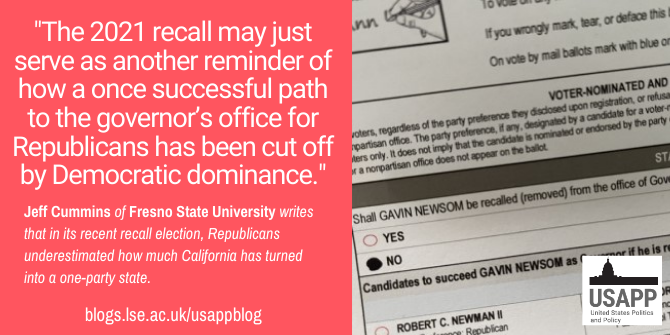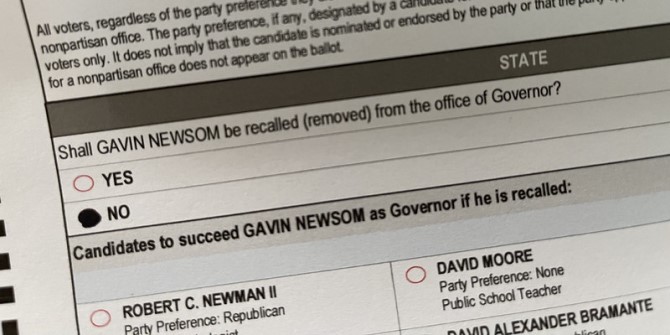 Last month, residents of the Golden State decided that Gavin Newsom would continue as California’s Democratic Governor following a recall attempt led by state Republicans. Jeff Cummins writes that Republicans ultimately misjudged the election; Californians were not frustrated enough with the state’s COVID-19 response to remove Newsom.
Last month, residents of the Golden State decided that Gavin Newsom would continue as California’s Democratic Governor following a recall attempt led by state Republicans. Jeff Cummins writes that Republicans ultimately misjudged the election; Californians were not frustrated enough with the state’s COVID-19 response to remove Newsom.
- Following the 2020 US General Election, our mini-series, ‘What Happened?’, explores aspects of elections at the presidential, Senate, House of Representative and state levels, and also reflects on what the election results will mean for US politics moving forward. If you are interested in contributing, please contact Rob Ledger (ledger@em.uni-frankfurt.de) or Peter Finn (finn@kingston.ac.uk).
The last time a Republican occupied the governor’s office in California, it began with a recall election of the incumbent Democrat Gray Davis in 2003. Having failed to win the governorship in the most populous state through regular elections since then, Republicans surmised that the current political environment and the composition of voters in a special election would tilt the outcome in their favor. While polling showed a glimmer of hope for support of the recall, indicating Republicans might have their shot at picking a successor, Democrats and their allies rallied behind incumbent Governor Gavin Newsom to ultimately crush Republican hopes for redemption in California.
The Pandemic Giveth and Taketh Away the Recall
It is important to note that the recall election would not have been possible without the COVID-19 pandemic. Recall proponents would never have gathered enough voter signatures, about 1.5 million, to qualify the recall petition for the ballot if a state judge had not extended the time allowed to collect the signatures because of the challenges posed by the pandemic. The relatively high number of signatures required paired with a limited time to collect them had doomed all 54 attempts in the past to recall a California governor, except the one in 2003.
Although two previous attempts to recall Newsom failed, his mishandling of the state’s response to the pandemic and his mask-less appearance at a luxurious luncheon for a lobbyist friend stoked new enthusiasm among Republicans and likely some Independents for the third recall effort. Governor Newsom’s on-again, off-again shutdown of businesses and schools across the state frustrated many Californians, leading to a decline in his approval ratings. With the vaccine rollout well underway in the first half of 2021, Governor Newsom announced a grand reopening of the state for June 15. When the recall qualified for the ballot, Democrats, controlling the state legislature, moved the recall election day up to September rather than waiting until November, anticipating that the state reopening and a COVID-19 retreat would create more favorable circumstances for his retention. In addition, October is the last month that the Governor can sign bills approved by the legislature into law. Some Democrats feared that unpopular decisions on those bills might increase support for a recall.
While Governor Newsom managed to deter any prominent Democrats from entering the race to replace him, Republicans had no shortage of candidates. Luckily for Newsom and Democrats, Larry Elder, a conservative radio host and Donald Trump disciple, emerged from the Republican pack to lead the polls as the replacement candidate. Elder proved to be an easy target for Newsom and his supporters as they vastly outspent recall backers. Bombarding the airwaves and internet, Newsom and company effectively nationalized the election, pitching an Elder administration as Trump’s second term confined just to California. Mask and vaccine mandates would be eliminated and send the state into another COVID-19 surge akin to Florida and Texas.

“Gavin Newsom recall ballot” (CC BY 2.0) by sarahstierch
Results Show Failed Republican Strategy
Republicans did get one thing right about the recall election. It did hinge on the state’s restrictive COVID-19 policies, but not in the way they anticipated. In perhaps another signal of the echo chambers that American political parties operate under, Republicans assumed that enough Californians were frustrated with the state lockdowns and Newsom’s liberal ways to push him out of office. However, exit polls revealed that only 28 percent of recall voters thought Newsom’s COVID-19 policies were too strict. That percentage is nearly the same as the percentage (27) of recall voters that were Republicans.
Republicans also assumed that low turnout and the composition of voters that typically appear in non-presidential elections would be in their favor. Again, Republicans underestimated how much California has turned into a one-party state. While Democrats are 47 percent of registered voters, Democrats exceeded this number in the recall accounting for 51 percent of returned ballots. Republicans represent 27 percent of returned ballots, only slightly above their share of registered voters at 24 percent.
In the beginning of August, polls suggested a close outcome, but, as the campaigns rolled into August, Democratic voters woke up to the potential nightmare of an Elder administration. Polls closer to election day indicated voters would overwhelmingly reject the recall. In the end, less than 60 percent of voters bothered to fill in the ballot to select a potential replacement candidate and Republicans were a plurality of that group. Ultimately, it was only a Republican recall as Newsom’s surrogates, including former President Barack Obama, had said in continuously looping campaign ads.
Attention Turns to Recall Overhaul
With a second gubernatorial recall election in less than 20 years, a cost of nearly $300 million, and the outcome now certain, public discourse has turned to revamping the recall process. The first set of reforms revolves around the threshold for triggering a recall. Some argue that the signature threshold to qualify a recall for the ballot (12 percent of voters in the last gubernatorial election) is too low, particularly in a highly partisan environment where out-of-power parties view it as their best shot at statewide office. One frequently discussed proposal would increase the signature threshold to 20 percent or more, which aligns with what other states with the recall do. Fifty-four percent of respondents in a recent survey from UC San Diego supported this idea.
The second set of reforms deals with the replacement election. The circus-like atmosphere of the campaign made possible by the low barrier for candidate entry and the possibility that the replacement winner could receive fewer votes on the ballot than the recalled governor have led to a public debate over alternatives for filling the empty seat. One way to fill the seat would be to simply allow the lieutenant governor to step into the role since that is the primary purpose of the position under other circumstances.
Regardless of the reforms chosen, the recall, with all its flaws, is here to stay. More than 70 percent of Californians support keeping the recall.
A Democratic Bellwether?
The blowout success against the California recall has raised optimism nationally among Democrats about a possible strategy for the 2022 midterm elections when the president’s party typically loses House seats. The Newsom playbook suggests wrapping the Trump albatross around Republicans’ necks and hammering home how dangerous opposition to masking and vaccine mandates can be. However, by next Fall, the elections may not hinge on COVID-19 policies unless another variant finds a way around the vaccines. Instead of providing a recipe for Democrats nationally, the 2021 recall may just serve as another reminder of how a once successful path to the governor’s office for Republicans has been cut off by Democratic dominance.
- Listen to Jeff Cummins on the Covid-19 and Democracy Podcast, 26 October 2021 episode, ‘An Afterthought in the Long-Run? The 2021 California Recall Election and Covid-19‘ hosted by Peter Finn.
Please read our comments policy before commenting.
Note: This article gives the views of the author, and not the position of USAPP – American Politics and Policy, nor the London School of Economics.
Shortened URL for this post: https://bit.ly/3uYnhGM
About the author
 Jeff Cummins – Fresno State University
Jeff Cummins – Fresno State University
Jeff Cummins is a Professor of Political Science at Fresno State University. He is the co-author of California: The Politics of Diversity (Rowman & Littlefield) and author of Boom and Bust: The Politics of the California Budget (Institute of Governmental Studies). His research interests include state politics and policy, electoral accountability, and presidential policymaking.





